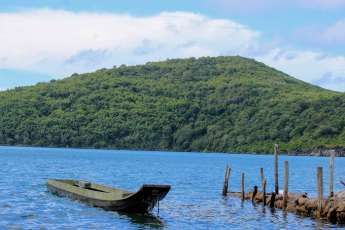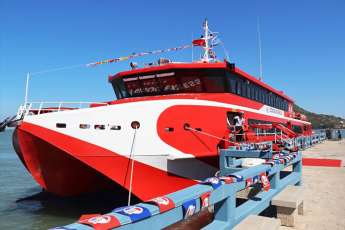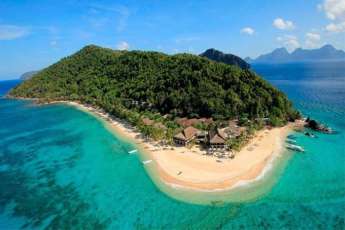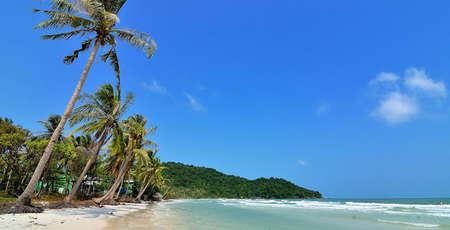
Enjoy the enchanting beauty of Bai Tu Long Bay
- on Aug 30, 2019 By: Ngoc Nguyen
Located right next to Ha Long Bay, this cousin of the world natural wonder entices those who are looking for landscapes that are just as picturesque as Ha Long Bay but without the crowds. Bai Tu Long Bay is undoubtedly a discreet beauty with many modest islets and deserted beaches with fine sand. It was voted by the British company Gecko Travel in its list of the 5 best destinations in South East Asia in 2006.
Location
It is located in the Gulf of Tonkin, south-west of Ha Long Bay and west of the town of Cam Pha. Covering nearly 1000 square meters this archipelago has nothing to be ashamed of when compared with Ha Long. It is composed of some 600 islands and islets many of which invite you to explore them for a few days.
Made up of hundreds of islands and islets, some of which are inhabited like Van Don, Quan Lan, Ban Sen and Ngoc Vung, Bai Tu Long Bay is home to many little known places when compared to the massive tourist paradise of Ha Long. The inhabitants of these islands mainly practice fishing and fish farming.
Ha Long and Bai Tu Long, a legendary family
The name Bai Tu Long is reminiscent of the name of Ha Long. Ha Long means descending dragon and Bai Tu Long means bowing son of the dragon.
These names originated from the legends of how the innumerable islands in the Tonkin gulf were formed. Thousands of multiform pitons were created following the movements of the mother dragon to save the Vietnamese from the Chinese invaders. The mother dragon's descent is now Ha Long Bay while her son’s is Bai Tu Long Bay. The Bach Long Vi Island is known for its strip of fine sand which is the trace of the lashing tail of the sacred dragons.
What to do and where to go in Bai Tu Long Bay?
Bai Tu Long Bay will not fail to astonish nature lovers with its majestic karst jewels, such as Bai Tho mountain (Poem), Con Coc islets (Frog), Tien Ong (Old Fairy), Con Rua (Tortoise), Mat Quy (Face of the Demon), Con Co (Stork) and the caves: Thien Canh Son, Tam Cung (Three Palaces), Me Cung (Labyrinth)...
Not to mention the beautiful beaches with fine sand like Con Co, Van Don, Co To, Quan Lan and Minh Chau. Each beach will fill your thirst for the sea and peacefulness.
You will also have the opportunity to explore Bai Tu Long National Park, a national biosphere reserve that is listed as an ASEAN Heritage Park. Here you will find exceptional biodiversity with rare animal and plant species and a varied environmental setting composed of rocky islets, valleys and creeks. All this makes for a small paradise between sea and land. The islands of Ba Mun, Tra Ngo Grand, Tra Ngo Small, Sau Nam, Dong Ma, Hon Chinh and especially Hang Doi Creek are known for their habitat of bats and all are worth visiting are.
To top off a day within this natural and cultural scenery some other stops which are also interesting are: Thong Thien cave, Phat Co Island and Cua Ong temple which is a historically rich and religiously important place of Quang Ninh province.

Aboard a classic cruise ship in Bai Tu Long you will have the chance to visit the beautiful Thien Canh Son cave, relax on Hon Co beach and meet the fishermen from Vung Vieng village.
For those wishing to extend the trip a little further away you can head to Co To, Quan Lan or Ngoc Vung. From Cai Rong Port it takes between 45 and 90 minutes by speed boat to reach them. Your patience will be completely rewarded once you arrive at this haven of peace on the high seas.
The best way to enjoy the charm of Bai Tu Long Bay is to cruise for two days and one night and ideally for three days and two nights. Getting away from the crowds and lounging from sunrise to sunset is an experience you should treat yourself to. Whether it be swimming, kayaking or relaxing by the sea under the sun, this place offers many sports and fun activities. It is an ideal trip to relax and share great moments with your loved ones.
When to go to Bai Tu Long Bay?
Due to its location in the eastern sea, Bai Tu Long has the same weather features as Ha Long with two distinct seasons. It is hot and humid in the summer during the months from April to August and winter lasts from November to March. Annual temperatures range from 15 ° C to 25 ° C.
The peak season for Vietnamese holidaymakers normally falls in the summer months. Winter is therefore preferred by foreign travellers for its dry weather and minimal traffic. Note that June and July are not recommended because of the heightened risk of rain or typhoons.
Related Articles:
>> Discover Cham Islands, the offshore call of Hoi An
>> Top 10 dream beaches in Vietnam
>> Ha My, a beach of Hoi An in the top of the most beautiful beaches in Asia
>> Ong Lang Beach, the hidden gem of Phu Quoc Island
Comment
Other Blog
Categories
Latest News
on 31 Dec, 2025
on 31 Dec, 2025
 Español
Español Français
Français




















Morgane Ter Cock
on Dec 18, 2025HerbertPhomaMS
on Oct 19, 2025Lilyan Cuttler
on Oct 15, 2025Avenue17XC
on Sep 14, 2025Avenue18JL
on Jul 21, 2025